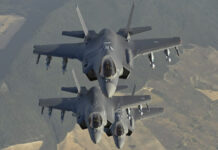While the air force completes procurement of its top-performance F-22, and gears toward fielding of the fifth-next generation F-35 stealth fighter, a modest effort is aimed at a different platform, less glamorous, perhaps, but not less suitable for irregular warfare, a type of conflict the Air Force is expected to support, but currently still lacks adequate means to deliver effectively.
As part of its new strategy, the U.S. Air Force is evaluating plans to buy about 160 light aircraft. These will include about 100 light attack/armed reconnaissance aircraft (LAAR) and 60 light transports, the so-called, light military aircraft (LiMA), optimized for irregular warfare operations.
LAAR could be operated from austere forward locations, remain airborne for several hours, survive relatively sophisticated threats, such as air defense missiles, as well as ground fire. It can support ground elements with intelligence, surveillance and reconnaissance (ISR), deliver precision guided weapons or conventional ordnance, with precision and effectiveness expected form the most sophisticated close-air-support aircraft. LAAR and LiMA can carry personnel and supplies into and out of hot battle zones.
The Air Force expects the new aircraft to become operational in 2013, one year after initial deliveries start. Procurement of up to 100 aircraft is planned. The Air Force expects the aircraft to be maintained by a civilian contractors, while supporting them at field level through its organic facilities. At present, Hawker Beechcraft Corp. (HBC) is offering the AT-6 variant of the T-6A/B trainer, to be equipped and supported by Lockheed Martin.Texas based Air Tractor is also expected to be offering the AT-802U unveiled earlier this year at the Paris Air Show. Embraer is also expected to bid, teamed with a local partner. While the Air Force has not specified an unmanned aerial system option, Proxy Aviation could also be offering the Skyraider optionally piloted UAV, which could introduce a totally new dimmension to LAAR capabilities.
At the same time, the Air Force also plans to introduce about 60 fixed-wing Light Mobility Aircraft (LiMA) aircraft with contracts expected in 2011. The aircraft will be optimized for Air Transport operations, supporting forward locations operating from makeshift landing ground. The aircraft are expected to conduct airlift of cargo and personnel, airdrops, forward operating location re-supply and medical/casualty evacuation. The aircraft will be able to carry at least six passengers with gross takeoff weight of 1,800 lbs., operating autonomously over a distance of 900 nautical miles with full cargo. Current U.S. manufacturers offering aircraft compatible with these requirements include the Explorer 500T from Texas based Explorer Aircraft or the Cessna Caravan. Yet eying the special operations character of these missions, few foreign aircraft could also be considered. Among those are the Swiss Pilatus PC6 Porter (below), the DH6 Twin Otter, a popular skydiving carrier being offered by Canadian Viking Air and the legendary Australian Nomad, which recently resurected by Gippsland Aeronautics.





















